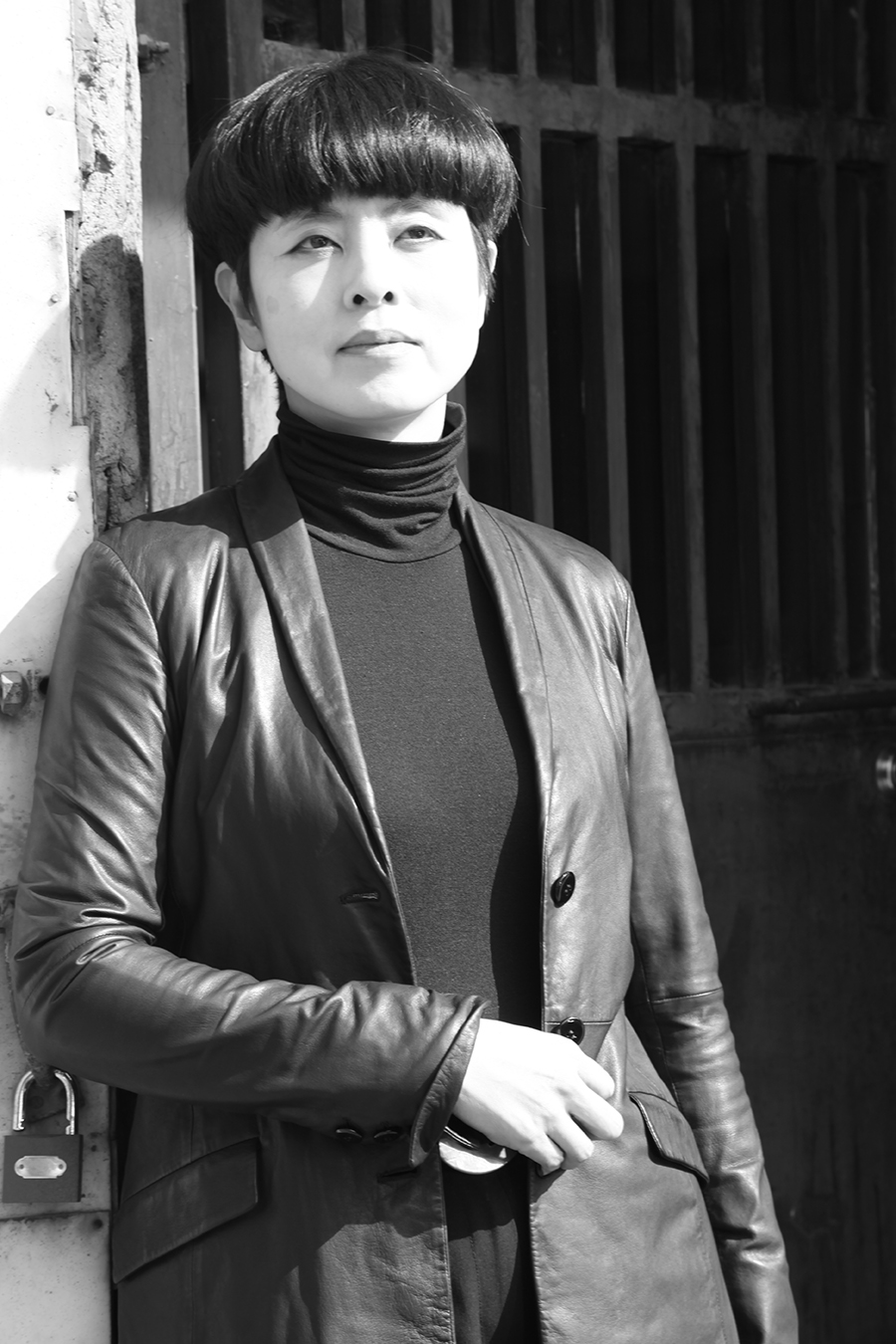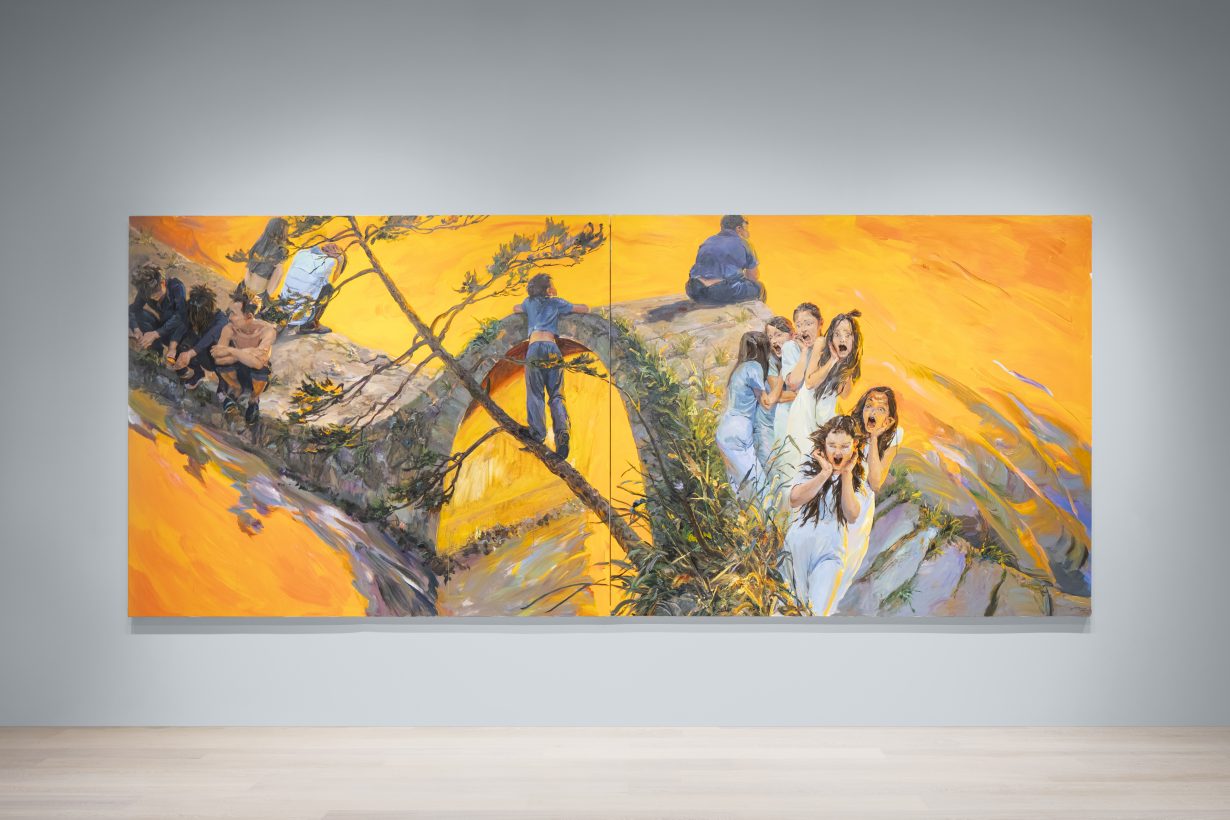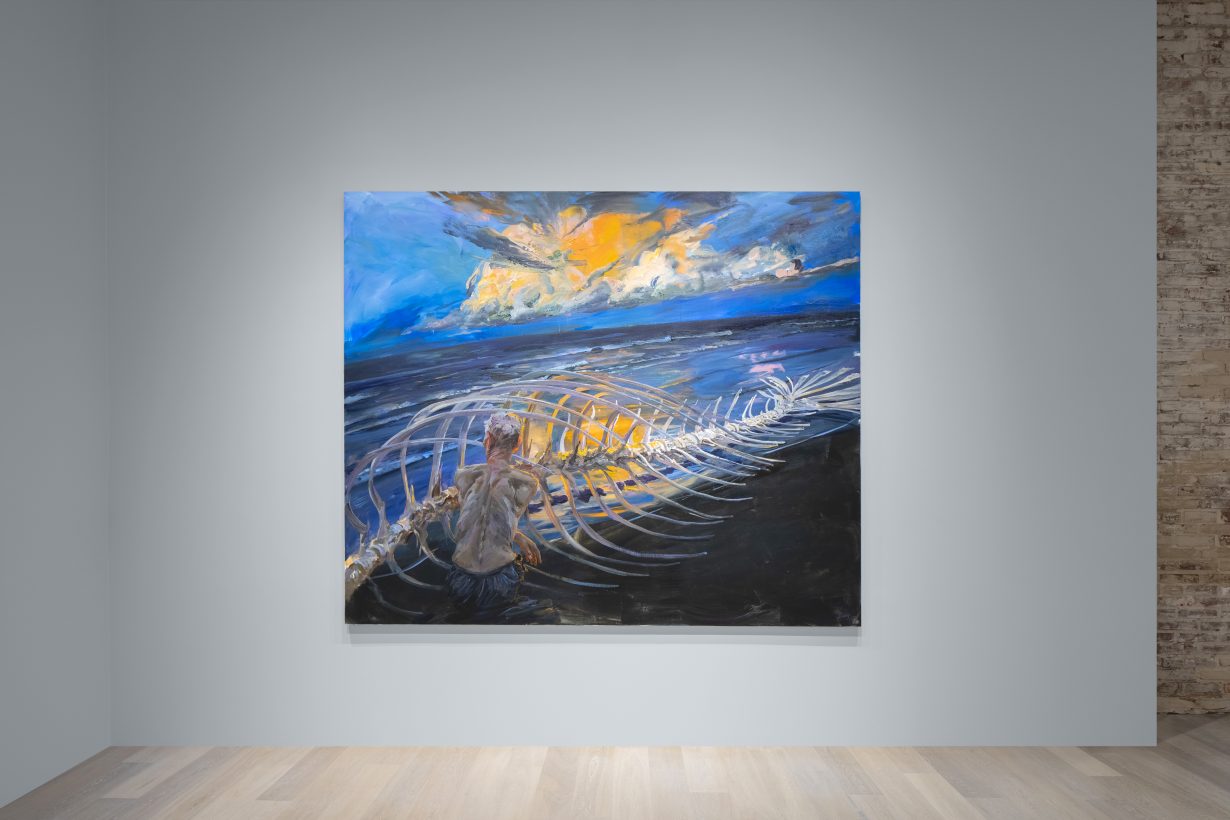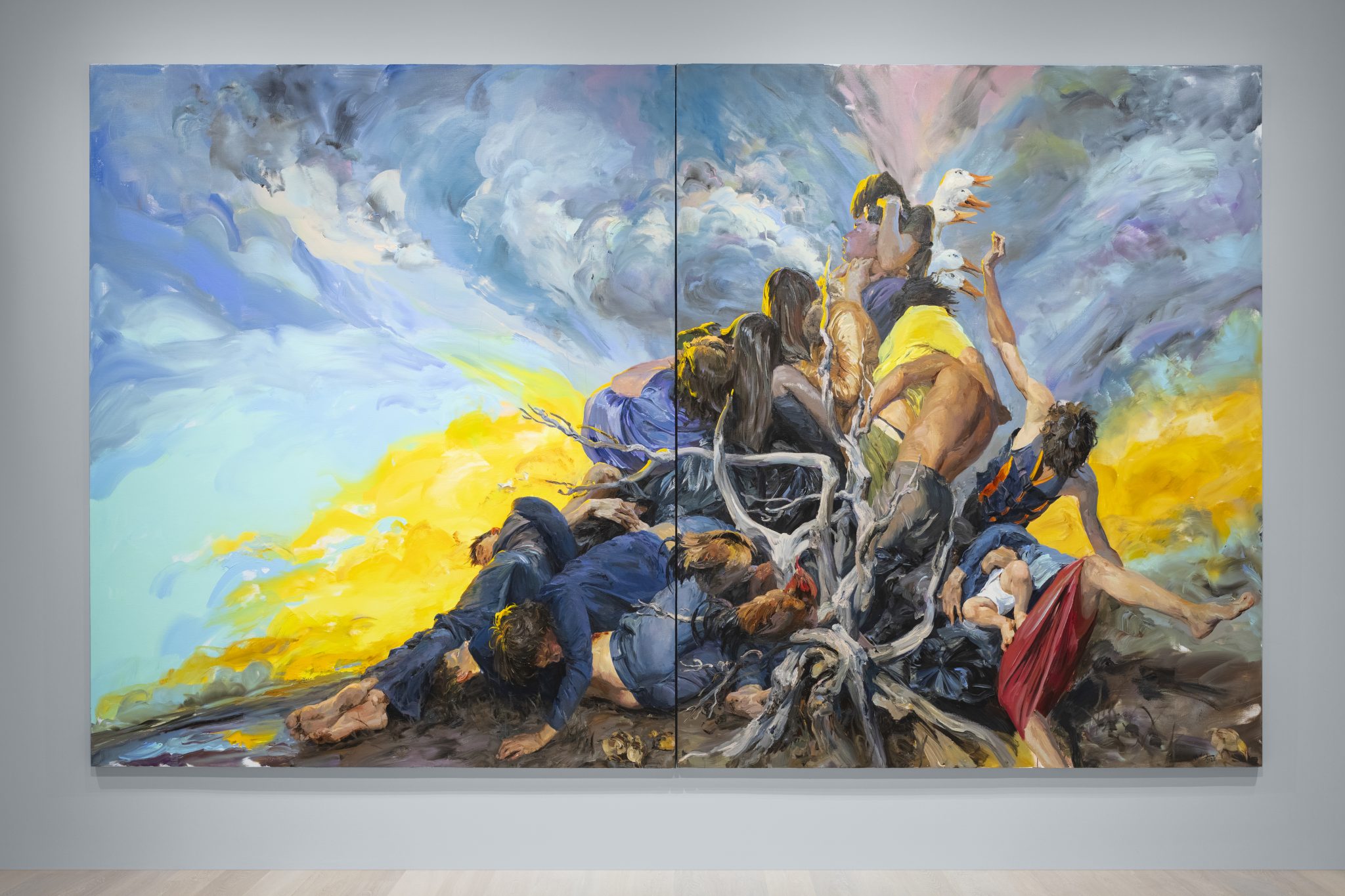On the occasion of her solo show at SCAD Museum of Art, Savannah, the artist spoke to ArtReview about colour, art historical and literary connections, and the psychological stressors of contemporary life
Yu Hong is best known for her paintings that blend stylistic influences adopted from the Western art historical canon and traditional Chinese painting techniques – resulting in expansive and dramatic landscapes, as well as quieter, more intimate moments. At her latest exhibition at SCAD Museum of Art, Savannah, Hong presents six largescale paintings of landscapes populated by human figures in varying states of distress that speak to the psychological stressors of contemporary life, alongside three small studies of hands that are pictured mid-gesture. The exhibition’s titular painting, Night Walk (2023), sets the tone of the exhibition, immersing visitors in a vibrant colour palette while inviting art historical and literary connections to be made with the subsequent paintings on view.

ArtReview Could we start with how you decided on the title Night Walk, not just for the painting itself, but the whole exhibition – and what this refers to?
Yu Hong Night Walk is one of the most important works in my solo exhibition at the SCAD Museum of Art, and it is also the largest one. It was created based on the painting The Blind Leading the Blind [1568] by Bruegel the Elder, which portrays a group of blind people supporting each other and leaning on their canes, moving forward in a perilous volcanic zone. Under the cover of night and fire, the scorching red light of the magma shines on their faces. Animals and children huddled on a tricycle look at the world shrouded in darkness, but they can only jolt forward under the guidance of the blind person in front of them. This work is full of a tense sense of crisis and has a strong visual impact. I named the painting Night Walk because it has a mysterious and unpredictable feeling. The exhibition curator, Daniel S. Palmer, had the idea of naming the exhibition after this painting, which I think is also in line with the turbulent times we live in. We cannot clear the road behind or ahead of us, so we have no choice but to explore and move forward in the dark.
AR In a similar vein to referencing The Blind Leading the Blind, your paintings allude to other well-known works like Théodore Géricault’s The Raft of Medusa [1818-19], Edvard Munch’s The Scream [1893] and Caspar David Friedrich’s Wanderer above the Sea of Fog [1818]. Can you tell us how these came to inspire you to make this series of work?
YH The paintings you mentioned are all classic paintings that I love very much. Géricault’s The Raft of Medusa, by way of using a dramatic and grand scene, shows a group of people in despair seeking a last glimmer of hope. Bruegel’s The Blind Leading the Blind vividly portrays human ignorance and blindness with a worldly yet absurd sense of humour. Munch’s The Scream portrays the loneliness and madness of fragile individuals. In Wanderer above the Sea of Fog, Friedrich shows us a lonely figure overlooking the vast world. These works all depict people in an anxious state trying to find direction when in crisis and turmoil. It is evident that although the problems and experiences faced by people in each era are greatly different, a human sense of anxiety and insecurity has permeated throughout human history, and countless painters have created works based on this. This is something that fascinates me, and it has become the core of my exhibition at the SCAD Museum of Art.

AR That sense of anguish, loss and desperation in the large-scale works – why is this something you wanted to portray?
YH The pain, loss and despair expressed in these large-scale works come from real life. In recent years, the impact of the pandemic and the changes in the world’s social patterns have overturned the established order and values. People have realised how small and helpless we are in front of the tide of our contemporary times; it has created a strong sense of imbalance. I have tried to express this sense of imbalance in my paintings.
AR There’s an interesting generational tension created by your paintings The Old Man and the Sea [2023] and The Scream [2020]: one depicts an elderly man alone on the shore, and the other presents a group of young people. Can you expand on the dynamics or relationship between these two paintings?
YH The painting The Scream originates from Munch’s painting. I selected the core elements of Munch’s painting – the sunset, the bridge and the central person screaming. I made the sunset more vibrant and fluid and I painted a Chinese-style arch bridge. I turned the lonely screaming figure in Munch’s painting into a group of young girls shouting in anger into the beautiful sunset, creating a sense of tension caused by conflicting emotions. The other painting, The Old Man and the Sea, is based on Ernest Hemingway’s 1952 novel. The old man’s bony back speaks of his desolate life. After a long struggle in the sea, the old man finally brings back a huge fish bone, which seems to be a manifestation of heroism, but in fact, it is more of sadness and helplessness. This painting is very quiet, as the old man quietly gazes at the sunset, at the calm sea surface, and at the fish bones lying on the beach. This kind of beautiful desolation and the craziness of The Scream next to it create a contrast between frenzy and madness on one hand, and quiet and loneliness on the other, and in that sense, reflects the different spirits of two generations.

AR The paintings Night Walk and The Scream seem to reflect on the shan shui style of painting – what’s the significance of traditional forms of Chinese painting in this series and how these might influence how we understand the subject matter?
YH Both of these paintings are horizontally composed on several panels, much like scrolls or album paintings of the shan shui style. Chinese scroll paintings and albums are viewed by the audience horizontally while moving. The characters in my paintings are life-size and, as the audience follow the canvases, they connect with the characters as they gaze at each other. During the viewing process, the scenery and characters move to the side, creating a sense of deep immersion as the scene unfolds. This would be in line with the way the shan shui style of painting is traditionally viewed.
AR There’s a really effective contrast between the expansive landscapes of the largescale paintings and the more intimate paintings of hands – creating a push and pull of a more outward-facing perspective and then introspection. What’s the relationship between these landscapes and these hands?
YH The works shown in this exhibition at the SCAD Museum of Art are mostly largescale paintings, which are both expansive and create a strong sense of tension. Three small studies of hands are displayed in the most secluded area of the gallery; these paintings happen to be the last works I completed for this exhibition. They form a contrast with the large landscape paintings because they are more personal and private. I believe that this contrast reflects the interconnectedness between the external turbulent world and the fragile inner self.

(from left to right) Companionship, Glow and Hands, all 2023, acrylic on canvas, 31 x 26 cm. Courtesy SCAD
AR The hands in Hands, Companionship and Glow [all 2023] remind me of Qu Leilei’s painting series To Face a New Century [1999] – a collection of gestures, which at a fundamental level remind us of our shared humanity. Is this something you were also thinking about when painting the hands? How do you think (or hope) your audience might respond to the gestures in your paintings?
YH The two slender hands in Hands are both beautiful and fragile. Companionship depicts the warmth and comfort of a man and a woman who have gone through decades of trials and tribulations in life together. The posture of the two hands in Glow refers to the instinctive reflex of humans to block and avoid danger or strong lights. These small works are more personal, fragile and sensitive compared to the large paintings. Although the hand is only a part of the body, if we compare it to the face, the hand can often reveal the true psychology of a person in a more effective way. I hope that when the audience sees these works, it will remind them that they might be able to read other people’s inner emotions and turmoil through their hands.
Night Walk at SCAD Museum of Art, through 29 January
